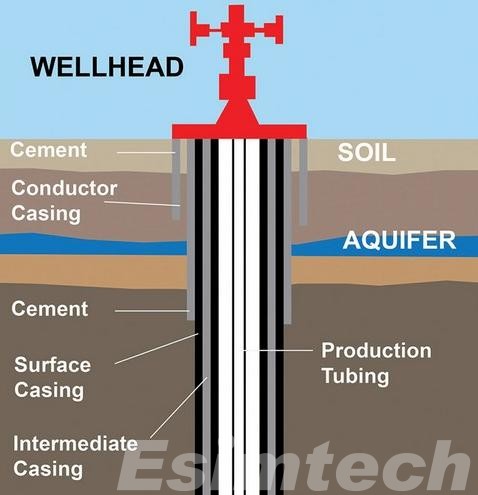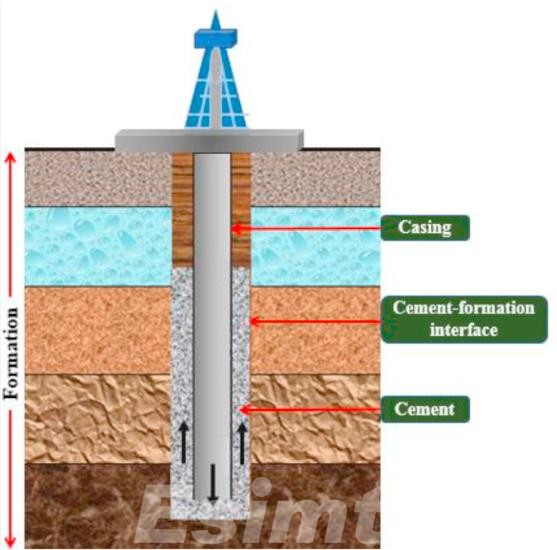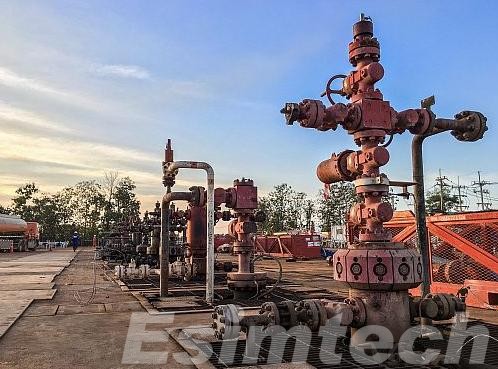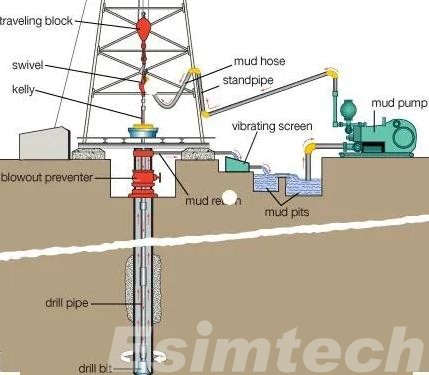The Critical Role of Wellbore Cementing in Ensuring Integrity
A wellbore is a vital passage drilled into the earth to access and extract oil, gas, or geothermal resources. However, a wellbore can also pose environmental and safety risks if not managed properly. This is where Well Integrity Management Systems (WIMS) come in, and wellbore cementing plays a critical role within these systems.
What is Well Integrity Management System

A Well Integrity Management System (WIMS) is a comprehensive framework designed to proactively safeguard the wellbore throughout its entire lifecycle. Imagine it as a roadmap that ensures the well’s structural integrity, preventing leaks and safeguarding the environment and personnel. WIMS encompasses a variety of activities that can be broken down into four key phases:
- Well Design and Planning: This phase involves meticulous planning of the wellbore, considering factors like geology, reservoir pressure, and potential hazards. It includes designing the well casing, selecting appropriate cement types, and outlining procedures for well construction and operation.
- Well Construction and Operation: During this phase, the well is drilled according to the plan, and the casing strings are installed. Wellbore cementing is performed at this stage to isolate zones and ensure wellbore stability. Throughout the operational life of the well, WIMS dictates procedures for monitoring well pressure, fluid levels, and any signs of deterioration that could compromise integrity.
- Well Intervention and Maintenance: As a well ages, interventions like wellbore cleanouts or repairs might be necessary. WIMS ensures these procedures are conducted safely and effectively, maintaining well integrity throughout its productive life.
- Well Abandonment and P&A (Plugging and Abandonment): When a well reaches the end of its economic life, it’s crucial to properly abandon it to prevent future leaks or environmental hazards. WIMS outlines procedures for well plugging and abandonment, ensuring the wellbore is permanently sealed and poses no risk to the surrounding environment.
By adopting a well-defined Well Integrity Management System (WIMS), oil and gas companies can showcase their dedication to responsible well management. This approach not only improves safety for both personnel and the environment but also minimizes the risk of expensive leaks and production interruptions. Wellbore cementing, as a crucial component of WIMS, is essential in reaching these objectives.
The Critical Role of Wellbore Cementing

Wellbore cementing plays a crucial role in the oil and gas industry. It is not only a crucial step in ensuring the integrity of the wellbore structure, but also has an undeniable impact on maintaining production safety, improving recovery rates, and protecting the environment. The following are several key points for wellbore cementing:
1. Sealing formation fluid: The primary task of wellbore cementing is to seal formation fluid and prevent cross contamination between groundwater, natural gas, and oil. This helps to maintain stable production of oil and gas wells, while preventing fluid mixing between different formations and avoiding accidents during the extraction process.
2. Protecting the wellbore structure: Good cement sealing can protect the wellbore structure from pressure and corrosion, prevent wellbore collapse, and ensure the safety of drilling and production channels.
3. Improving oil and gas recovery: By effectively cementing the wellbore, the recovery rate of oil and gas wells can be improved. For example, by using high-performance cement and additives, the flowability and stability of cement slurry can be improved, ensuring that the cement slurry can be uniformly filled into the wellbore and form a good sealing effect.
4. Environmental protection: Cementing in the wellbore also helps to protect the environment, prevent oil and gas leakage to the surface or groundwater, and reduce the impact on the ecosystem.
5. Economic benefits: By optimizing the cement slurry formula and construction technology, production costs can be reduced, while improving cementing quality and ensuring long-term stable production of oil and gas wells.
In summary, wellbore cementing is an indispensable part of the oil and gas extraction process, which is of great significance for ensuring stable production of oil and gas wells and improving extraction efficiency. With the development of technology, new cement materials and cementing techniques will further improve the efficiency and quality of cementing, making contributions to the sustainable development of the oil and gas industry.
Optimizing Wellbore Cementing for Enhanced Well Integrity

Wellbore cementing is a crucial yet complex operation. Optimizing this process requires careful consideration of several factors to achieve robust well integrity. Here’s a deeper dive into key aspects of optimization:
1. Cement Selection
Different cement types possess varying properties suited for specific downhole conditions. Selecting the right cement involves analyzing factors like:
- Wellbore temperature and pressure: High-temperature, high-pressure (HTHP) wells require specialized cements formulated to withstand these extremes without compromising strength or setting times.
- Formation characteristics: Corrosive fluids or reactive formations necessitate cements with superior resistance to these elements.
- Zonal isolation requirements: For wells with multiple producing zones, isolating each zone effectively may require specialized cement blends or additives that promote zonal isolation.
2. Cement Slurry Design
The cement slurry, a mixture of cement, water, and various additives, plays a critical role in successful placement and performance. Optimization involves:
- Fluid properties: The slurry’s density and rheology (flow behavior) need to be tailored to ensure proper placement within the wellbore geometry. For instance, in deviated or horizontal wells, specialized additives may be needed to prevent the slurry from settling prematurely.
- Setting time control: Setting time refers to the time it takes for the cement to harden. This needs to be carefully controlled to allow for proper placement before solidification but ensure the cement sets before encountering formation fluids that could compromise its strength.
- Fluid loss control: Fluid loss refers to water migrating from the slurry into the formation. Excessive fluid loss can lead to channeling (uneven placement) and compromise the cement’s strength. Fluid loss additives can be incorporated to mitigate this issue.
- Cementing Job Execution: Careful planning and flawless execution are paramount for successful wellbore cementing. This includes:
- Casing centralization: Centralizers ensure the casing is positioned properly within the wellbore, allowing for uniform cement placement around the casing.
- Displacement techniques: Techniques like mud displacement with the cement slurry are crucial to ensure complete removal of drilling fluids and proper placement of the cement.
- Real-time monitoring: Utilizing downhole monitoring tools allows for real-time data on pressure, temperature, and other parameters during the cementing job. This data is vital for identifying potential issues and ensuring a successful operation.
Challenges and Considerations in Wellbore Cementing

While wellbore cementing is essential for well integrity, it’s not without its complexities. Here’s a deeper dive into the challenges and considerations that demand careful attention:
Harsh Downhole Conditions
- High Temperatures and Pressures (HPHT): As wells go deeper, they encounter extreme temperatures and pressures. These conditions can significantly impact the setting time and strength development of cement. Special HPHT cement blends and additives are needed to ensure the cement cures properly and maintains its integrity under such duress.
- Corrosive Fluids: Certain formations contain corrosive fluids like hydrogen sulfide (H2S) or carbon dioxide (CO2) that can degrade the cement over time. Selecting cement resistant to these specific fluids is crucial to prevent wellbore leaks and potential environmental risks.
Uneven Cement Placement
- Wellbore Geometry: Wellbores can be straight or have complex deviations and inclines. Achieving uniform cement placement throughout a deviated wellbore is difficult. Techniques like centralizers and displacement fluids can help ensure complete coverage around the casing and prevent channeling (passageways for fluids to migrate).
- Fluid Displacement: Displacing the drilling fluid (mud) with the cement slurry is critical. Incomplete mud removal can compromise the bond between the cement and the casing or formation, leading to leaks. Effective spacer fluids and pumping techniques are employed to maximize mud removal and achieve optimal cement placement.
Verification and Monitoring
- Limited Downhole Visibility: Directly observing the quality and placement of cement downhole is impossible. Well integrity engineers rely on indirect methods like cement evaluation logs that measure various properties of the cement sheath. While these logs provide valuable data, interpreting them accurately requires expertise and experience.
- Microscopic Leaks: Even a seemingly perfect cement job might have microscopic channels or imperfections undetectable by current logging tools. These may allow slow fluid migration over time, posing a long-term well integrity risk. Ongoing research into advanced monitoring techniques and materials that self-heal micro-cracks are promising areas for future advancements.
By acknowledging these challenges and implementing best practices in cement selection, slurry design, job execution, and monitoring, wellbore cementing can be a highly effective technique to ensure long-term well integrity and safe resource extraction.
Conclusion
Wellbore cementing is a complex and critical aspect of well integrity management that involves numerous challenges and considerations. Harsh downhole conditions, effective mud removal, cementing in deviated and horizontal wells, and ensuring long-term integrity all require careful planning, advanced materials, and innovative techniques. By continuously improving cementing practices and leveraging new technologies, the industry can enhance well performance and extend the productive life of wells.
